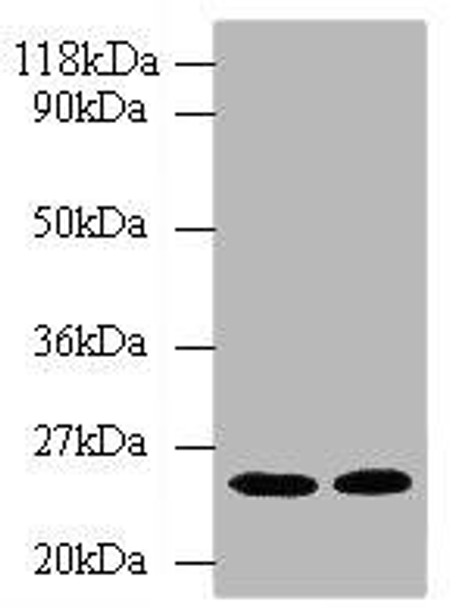HMGCR Antibody (PACO27393)
- SKU:
- PACO27393
- Product type:
- Antibody
- Reactivity:
- Human
- Host Species:
- Rabbit
- Isotype:
- IgG
- Application:
- ELISA
- Application:
- WB
- Application:
- IHC
- Application:
- IF
- Antibody type:
- Polyclonal
- Conjugation:
- Unconjugated
Description
| 抗体名: | HMGCR Antibody (PACO27393) |
| 抗体コード: | PACO27393 |
| サイズ: | 50ug |
| 宿主種: | Rabbit |
| 申し込み: | ELISA, WB, IHC, IF |
| 推奨される希釈: | ELISA:1:2000-1:10000, WB:1:500-1:2000, IHC:1:200-1:500, IF:1:50-1:200 |
| 反応性: | Human |
| 免疫原: | Recombinant Human 3-hydroxy-3-methylglutaryl-coenzyme A reductase protein (588-887AA) |
| 憲法: | Liquid |
| ストレージバッファ: | Preservative: 0.03% Proclin 300 Constituents: 50% Glycerol, 0.01M PBS, PH 7.4 |
| 精製方法: | >95%, Protein G purified |
| 抗体のクローン性: | Polyclonal |
| アイソタイプ: | IgG |
| Conjugate: | Non-conjugated |
 | Western blot All lanes: HMGCR antibody at 2µg/ml Lane 1: Hela whole cell lysate Lane 2: 293T whole cell lysate Secondary Goat polyclonal to rabbit IgG at 1/10000 dilution Predicted band size: 98, 93, 100 kDa Observed band size: 25 kDa . |
 | IHC image of PACO27393 diluted at 1:200 and staining in paraffin-embedded human pancreatic cancer performed on a Leica BondTM system. After dewaxing and hydration, antigen retrieval was mediated by high pressure in a citrate buffer (pH 6.0). Section was blocked with 10% normal goat serum 30min at RT. Then primary antibody (1% BSA) was incubated at 4°C overnight. The primary is detected by a biotinylated secondary antibody and visualized using an HRP conjugated SP system. |
 | Immunofluorescent analysis of HepG2 cells using PACO27393 at dilution of 1:100 and Alexa Fluor 488-congugated AffiniPure Goat Anti-Rabbit IgG(H+L). |
| バックグラウンド: | Transmembrane glycoprotein that is the rate-limiting enzyme in cholesterol biosynthesis as well as in the biosynthesis of nonsterol isoprenoids that are essential for normal cell function including ubiquinone and geranylgeranyl proteins. |
| シノニム: | 3-hydroxy-3-methylglutaryl-coenzyme A reductase (HMG-CoA reductase) (EC 1.1.1.34), HMGCR |
| UniProt Protein Function: | HMGCR: the rate-limiting enzyme for cholesterol synthesis. Regulated via a negative feedback mechanism mediated by sterols and non-sterol metabolites derived from mevalonate, the product of the reaction catalyzed by this reductase. Normally in mammalian cells this enzyme is suppressed by cholesterol derived from the internalization and degradation of low density lipoprotein (LDL) via the LDL receptor. Competitive inhibitors of the reductase induce the expression of LDL receptors in the liver, which in turn increases the catabolism of plasma LDL and lowers the plasma concentration of cholesterol, an important determinant of atherosclerosis. |
| UniProt Protein Details: | Protein type:EC 1.1.1.34; Secondary Metabolites Metabolism - terpenoid backbone biosynthesis; Endoplasmic reticulum; Membrane protein, integral; Motility/polarity/chemotaxis; Oxidoreductase; Membrane protein, multi-pass Chromosomal Location of Human Ortholog: 5q13.3-q14 Cellular Component: peroxisomal membrane; endoplasmic reticulum membrane; endoplasmic reticulum; integral to membrane Molecular Function:protein binding; hydroxymethylglutaryl-CoA reductase (NADPH) activity; protein homodimerization activity; hydroxymethylglutaryl-CoA reductase activity; coenzyme binding Biological Process: negative regulation of MAP kinase activity; isoprenoid biosynthetic process; positive regulation of smooth muscle cell proliferation; positive regulation of skeletal muscle development; cellular lipid metabolic process; cholesterol biosynthetic process; positive regulation of stress-activated MAPK cascade; coenzyme A metabolic process; myoblast differentiation; ubiquinone metabolic process; response to ethanol; negative regulation of vasodilation; visual learning; protein tetramerization; response to nutrient; aging |
| NCBI Summary: | HMG-CoA reductase is the rate-limiting enzyme for cholesterol synthesis and is regulated via a negative feedback mechanism mediated by sterols and non-sterol metabolites derived from mevalonate, the product of the reaction catalyzed by reductase. Normally in mammalian cells this enzyme is suppressed by cholesterol derived from the internalization and degradation of low density lipoprotein (LDL) via the LDL receptor. Competitive inhibitors of the reductase induce the expression of LDL receptors in the liver, which in turn increases the catabolism of plasma LDL and lowers the plasma concentration of cholesterol, an important determinant of atherosclerosis. Alternatively spliced transcript variants encoding different isoforms have been found for this gene. [provided by RefSeq, Aug 2008] |
| UniProt Code: | P04035 |
| NCBI GenInfo Identifier: | 123343 |
| NCBI Gene ID: | 3156 |
| NCBI Accession: | P04035.1 |
| UniProt Secondary Accession: | P04035,Q8N190, B7Z3Y9, |
| UniProt Related Accession: | P04035 |
| Molecular Weight: | 888 |
| NCBI Full Name: | 3-hydroxy-3-methylglutaryl-coenzyme A reductase |
| NCBI Synonym Full Names: | 3-hydroxy-3-methylglutaryl-CoA reductase |
| NCBI Official Symbol: | HMGCR |
| NCBI Official Synonym Symbols: | LDLCQ3 |
| NCBI Protein Information: | 3-hydroxy-3-methylglutaryl-Coenzyme A reductase; HMG-CoA reductase; hydroxymethylglutaryl-CoA reductase; 3-hydroxy-3-methylglutaryl CoA reductase (NADPH) |
| UniProt Protein Name: | 3-hydroxy-3-methylglutaryl-coenzyme A reductase |
| UniProt Gene Name: | HMGCR |
| UniProt Entry Name: | HMDH_HUMAN |
| Secondary Antibody |
| Anti-HRP Goat Anti-Rabbit IgG (H+L) Antibody (CABS014) |
| Recommended Products |
| Anti-FITC Goat Anti-Rabbit IgG (H+L) Antibody (CABS011) |
| Anti-HRP-conjugated Beta Actin Antibody (CABC028) |

